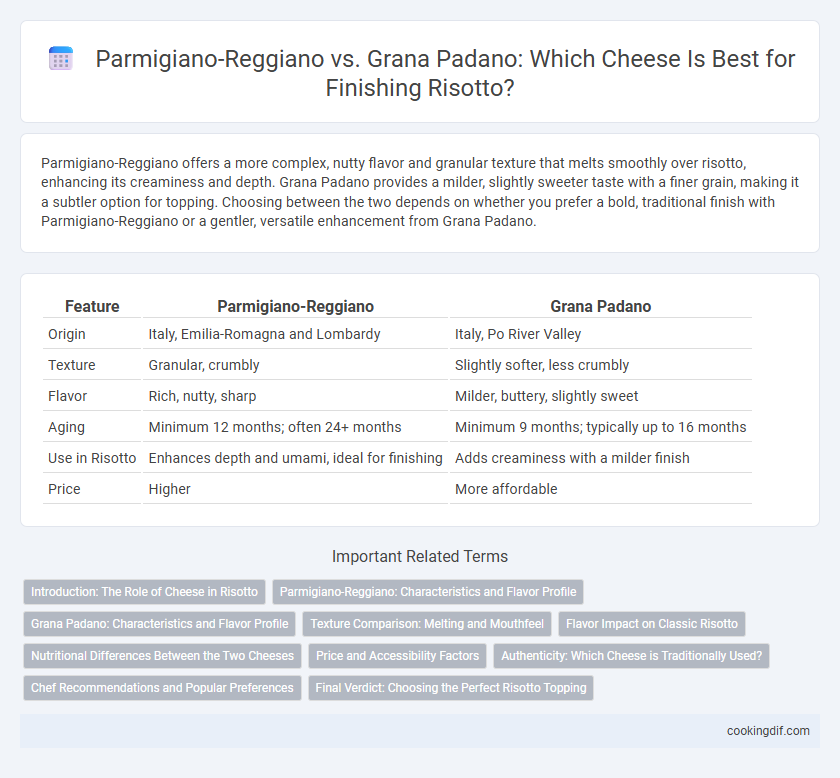Parmigiano-Reggiano offers a more complex, nutty flavor and granular texture that melts smoothly over risotto, enhancing its creaminess and depth. Grana Padano provides a milder, slightly sweeter taste with a finer grain, making it a subtler option for topping. Choosing between the two depends on whether you prefer a bold, traditional finish with Parmigiano-Reggiano or a gentler, versatile enhancement from Grana Padano.
Table of Comparison
| Feature | Parmigiano-Reggiano | Grana Padano |
|---|---|---|
| Origin | Italy, Emilia-Romagna and Lombardy | Italy, Po River Valley |
| Texture | Granular, crumbly | Slightly softer, less crumbly |
| Flavor | Rich, nutty, sharp | Milder, buttery, slightly sweet |
| Aging | Minimum 12 months; often 24+ months | Minimum 9 months; typically up to 16 months |
| Use in Risotto | Enhances depth and umami, ideal for finishing | Adds creaminess with a milder finish |
| Price | Higher | More affordable |
Introduction: The Role of Cheese in Risotto
Parmigiano-Reggiano and Grana Padano both serve as essential finishing cheeses in risotto, contributing distinct flavors and textures. Parmigiano-Reggiano offers a rich, nutty complexity with a granular texture that enhances risotto's creamy consistency. Grana Padano provides a milder, slightly sweeter taste with a finer grain, creating a subtle but savory finish that balances the dish.
Parmigiano-Reggiano: Characteristics and Flavor Profile
Parmigiano-Reggiano offers a rich, nutty flavor with complex savory notes and a granular texture that melts beautifully in risotto, enhancing its creaminess without overpowering the dish. This cheese is aged a minimum of 12 months, developing a depth of flavor that balances saltiness and umami, making it the preferred topping for traditional risotto recipes. Compared to Grana Padano, Parmigiano-Reggiano provides a more intense aroma and sharper taste, contributing to a luxurious finish in every bite.
Grana Padano: Characteristics and Flavor Profile
Grana Padano offers a delicate, nutty flavor with a slightly sweet undertone, making it an excellent choice for finishing risotto. Its semi-hard texture melts smoothly, enhancing the creamy consistency without overpowering other ingredients. Compared to Parmigiano-Reggiano, Grana Padano provides a milder, less salty profile, ideal for those seeking a balanced, subtle cheese topping.
Texture Comparison: Melting and Mouthfeel
Parmigiano-Reggiano melts smoothly into risotto, creating a creamy texture that enhances the dish's mouthfeel with a delicate, crumbly finish. Grana Padano offers a slightly firmer texture when melted, contributing a subtle graininess and less buttery creaminess compared to Parmigiano-Reggiano. The choice affects the risotto's overall creaminess, with Parmigiano-Reggiano providing a richer, more velvety experience while Grana Padano imparts a lighter, more textured finish.
Flavor Impact on Classic Risotto
Parmigiano-Reggiano offers a more intense and complex umami flavor compared to Grana Padano, enhancing the depth and richness of classic risotto. Its granular texture and aged notes provide a sharp, nutty finish that elevates the creamy consistency of the dish. Grana Padano, though milder and less aged, imparts a subtler cheese presence, making it suitable for lighter risottos where a delicate flavor balance is desired.
Nutritional Differences Between the Two Cheeses
Parmigiano-Reggiano contains higher protein levels, typically around 38 grams per 100 grams, compared to Grana Padano's approximately 33 grams. Grana Padano tends to have slightly more fat, averaging 29 grams per 100 grams, whereas Parmigiano-Reggiano has about 28 grams. Both cheeses provide essential calcium and phosphorus, but Parmigiano-Reggiano often features a greater concentration of these minerals due to its longer aging process.
Price and Accessibility Factors
Parmigiano-Reggiano, known for its rich umami flavor, tends to be pricier due to strict production regulations and aging requirements, making it less accessible in some regions. Grana Padano, while offering a similar texture and flavor profile, is generally more affordable and widely available because of its broader production standards. Choosing Grana Padano for risotto topping balances cost-effectiveness with authentic Italian taste without compromising quality.
Authenticity: Which Cheese is Traditionally Used?
Parmigiano-Reggiano is traditionally used as the authentic final topping for risotto, known for its rich, nutty flavor and granular texture that enhances the dish. Grana Padano, while similar and more widely available, originates from a broader production area and offers a milder taste with a creamier texture. For an authentic risotto experience, Parmigiano-Reggiano's strict production standards and aged complexity make it the preferred choice among Italian chefs.
Chef Recommendations and Popular Preferences
Chefs often recommend Parmigiano-Reggiano for risotto topping due to its complex, nutty flavor and granular texture that enhances the dish's creaminess. Grana Padano, favored for its milder taste and slightly softer texture, is popular among home cooks seeking a more subtle cheese finish. Both cheeses melt well, but Parmigiano-Reggiano's robust flavor profile remains the preferred choice in professional kitchens for authentic risotto.
Final Verdict: Choosing the Perfect Risotto Topping
Parmigiano-Reggiano offers a more robust, nutty flavor with a granular texture that melts beautifully into risotto, elevating its creamy consistency. Grana Padano provides a milder, slightly sweeter taste and is often more budget-friendly while still enhancing the dish's richness. For the perfect risotto topping, Parmigiano-Reggiano is the preferred choice when seeking depth and complexity, whereas Grana Padano suits those who desire a subtler, smoother finish.
Parmigiano-Reggiano vs Grana Padano for final topping Infographic

 cookingdif.com
cookingdif.com